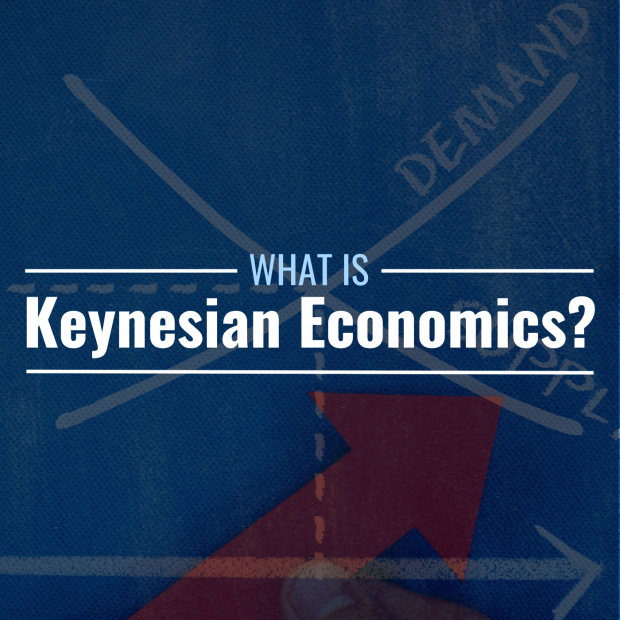
What Is Keynesian Economics?
Keynesian economics is an economic school of thought, and the basic premise of this particular theory is that aggregate demand serves as the primary driver of a nation’s economic activity and employment.
This branch of economics was named after John Maynard Keynes, a British economist who warned about the damaging effects of harsh reparation payments from Germany for World War I and was a proponent of the quantity theory of money known as monetarism, which advocates manipulating money supply to influence the economy.
Keynesian economics came at a time when the world was experiencing the Great Depression. His book The General Theory of Employment, Interest and Money, published in 1936, used as examples the fluctuations of economic activity during the Great Depression and inadequate demand. The book introduced a new way of thinking about economics, in which consumer spending and government intervention could boost economic growth and create jobs.
Keynes suggested that a government take action to increase spending on goods and services in response to low economic activity and increased unemployment. Prior to World War II, the U.S., the U.K., and other Western countries largely operated on the classical economics model, in which markets operated freely and there was minimal government interference.
What Are the Main Points of Keynesian Economics?
Keynesian economic theory stresses a few main points, , including measures that could be undertaken to implement Keynes’ theory.
Aggregate Demand
Aggregate demand refers to total spending for all goods and services in an economy, and that includes consumer spending, investment, government spending, and net exports. According to Keynesian theory, as demand increases, employment, income, and economic output should also increase. On the flip side, insufficient demand can lead to recessions and high unemployment. Keynesian economics focuses on demand influencing a nation’s economy. Consumer spending, investment, and government spending could boost aggregate demand in times of recession.
Government Intervention
Keynes posited that a government needs to intervene to stabilize the economy in an absence or decline in spending by the private sector. The government can borrow (through the sale of bonds) to finance spending initiatives, such as construction projects, to boost employment and inject money into the economy. In short, Keynesian economic theory outlines that government intervention can help an economy achieve stability and full employment.
The Keynesian Multiplier
The multiplier effect in Keynesian economics asserts that spending at the government level can have a large impact on aggregate demand and economic growth. An increase in government spending would likely encourage consumers and businesses to spend more, giving a boost to economic activity. In other words, money that is spent by the government would work its way to consumers and businesses.
Active Fiscal and Monetary Policies
Reducing taxes and lowering interest rates via fiscal and monetary policies can have a direct effect in spurring aggregate demand. During times of recession, lowering taxes and increasing government spending could boost demand and stimulate economic activity. In other words, when people have more money in their pockets, they are more likely to spend.
What Are the Downsides to Keynesian Economics?
Implementing Keynesian economic theory during times of recession tends to be effective in jump starting an economic recovery. Still, there are concerns that measures tied to Keynesian economics can have negative outcomes.
Fiscal policy measures meant to stimulate the economy can lead to wider budget deficits and rising public debt. A government that borrows too much, or exceeds a particular ratio of debt to GDP, could face a weaker currency in the foreign exchange market, and in turn need to focus whatever future surpluses it has in the budget to repay that debt.
Inflation could accelerate as a pick-up in demand leads to higher prices and wages. Economists are concerned that a reliance on government intervention could stunt productivity and efficiency in the private sector.
How Influential Was Keynesian Economics?
Keynesian economics was popular from the end of World War II to the 1970s, when it gave way to supply-side economics, which put an emphasis on production and supply by focusing on businesses and manufacturers driving economic growth. Keynesian economics made a comeback during the financial crisis of 2007–2008, when Federal Reserve officials grappled with the deepest recession in the U.S. since the Great Depression and sought measures to mitigate a lengthy economic downturn.
2 Major Terms Associated With Keynesian Economics
Several pieces of economic jargon have emerged from Keynesian economics.
Among them is deficit spending, which means that the government spends more than it takes in revenue, usually by borrowing more than it takes in from tax collections, as a means of stimulating the economy.
Another is economic stimulus. When the government intervenes in the economy, it can do so via economic stimulus in the form of cash handouts or via fiscal or monetary policy measures.







